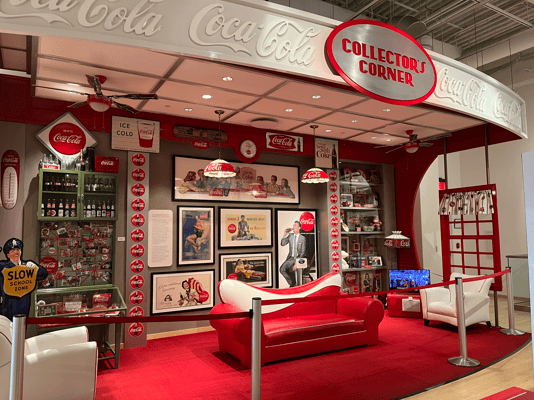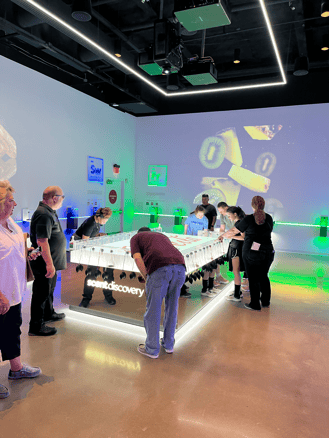Earlier this month, I took a trip down to Atlanta, Georgia -- also known as the birthplace Coca-Cola! During my stay, I visited the World of Coca-Cola, a museum dedicated to the history of America's favorite beverage. Along the way, I learned some cool things about the creation and innovation of Coke:

Me at the World of Coca-Cola. Coca-Cola was first served at soda fountains found within pharmacies, which looked a lot like the one in this picture!
- Coca-Cola was created by a… pharmacist?
Coca-Cola was created on May 8, 1886 by Atlanta pharmacist John S. Pemberton. It might sound a bit strange that a soft drink had its start in the medical field, but back in the day, pharmacies had vials of various chemicals and ingredients that could be combined to create syrups, and it wasn’t uncommon for pharmacists to create their own “secret formulas”. Soon, pharmacists began to wonder whether these syrups could double as a recreational drink in addition to being a medical anecdote. Granted, there wasn’t a whole lot of regulation on what sort of ingredients could go into a drink at the time, so all that it boiled down to essentially was finding the right kind and balance of ingredients to create a drink that tasted good. Then over the years, pharmacies began to install soda fountains where they could mix carbonated water in with these syrups to create what we now know as soft drinks! Fun fact: when Coca-Cola was first introduced at Jacobs’ Pharmacy in Atlanta, only nine glasses were sold each day and was worth 5 cents a glass!
- The creation of Coca-Cola didn’t come without its share of conspiracy theories.
Something that was jarring for me was how many rumors swirled around the original Coca-Cola drink. There was one section of an exhibit that was dedicated solely to the various claims the media made and speculations the public had about Coca-Cola. It just goes to show that even for a product that we know is highly successful today, it still had to overcome vast skepticism at the start (a common thread in innovation and new product development)! Here are some of the urban legends I read while going through the exhibit:
- Only two people were trusted with the Coca-Cola recipe, although neither one of them knew the whole recipe – one person knew the first half and the other knew the second half. Also, these two people never travelled together – one would fly by plane, while the other always took a train.
- That Coca-Cola was actually created by a female, and that Pemberton had copied her pretending to be the actual creator.
- That Coca-Cola can dissolve a human tooth overnight.
 An exhibit showcasing the various types of Coca-Cola branded pop culture items -- I love the lamps and the couch!
An exhibit showcasing the various types of Coca-Cola branded pop culture items -- I love the lamps and the couch!
- Coca-Cola was a marketing pioneer.
I never realized how innovative Coca-Cola was with their product marketing, especially back in the day. One of the major marketing innovations that Coke had created was the shape of their bottle! According to a Coca-Cola design brief, the configuration of the bottle had to meet the following three pieces of criteria: it had to be a shape that easily/naturally fit in one’s hand, had an attractive appearance, and “could be recognized by touch in the dark or when lying broken on the ground”. The importance that they placed on package design had helped them stand out from other similar soft drink products. Same goes for the “Coca-Cola red” that we have all seen wrapped around their cans – there’s no denying how strong their brand recognition is.
Additionally, Coca-Cola was the first company to introduce the widespread use of sample coupons. The coupons were redeemed at soda fountains to get a free Coke. By 1920, 1 out of 9 people in the U.S. had sampled a free Coca-Cola!
- Coca-Cola launched a new product that was a major flop.
Coca-Cola is constantly creating new drink products in several categories – their expansive portfolio includes teas, sports drinks, soft drinks, water, juice, milk, etc. as well as line extensions of existing products (think Coke Zero, Diet Coke, Cherry Coke). But as is common in new product development endeavors, not all of them can be winners. An example of this would be when the Coca-Cola company decided to reformulate the original Coke and introduced it as “New Coke”. This New Coke underwent major market research before launch and the feedback they were getting from blind taste tests pointed to a very successful product launch. However, New Coke was met with vast protests and heavy criticism once it entered the market – everyone missed the “old” Coke! Within 79 days, New Coke was pulled from the shelves for good. In this situation, Coca-Cola did not anticipate how generations of deep customer loyalty would factor into this launch. So, even though the blind taste tests confirmed that New Coke was a better tasting product than the original Coke, customers’ perceptions confirmed otherwise. Remember: marketing is a battle of perceptions, not products!
 The new ScentLab exhibit at the World of Coca-Cola. There were different beakers at the table in the middle where you could squeeze a pump and guess which scent was in each container. Each scent fell into one of the three main taste profiles that are incorporated into Coca-Cola: spicy, sweet, and fruity!
The new ScentLab exhibit at the World of Coca-Cola. There were different beakers at the table in the middle where you could squeeze a pump and guess which scent was in each container. Each scent fell into one of the three main taste profiles that are incorporated into Coca-Cola: spicy, sweet, and fruity!
Overall, these are just a few of the interesting facts that I learned during my trip to the World of Coca-Cola. If you ever happen to be in the Atlanta area, I encourage you to stop by and check it out for yourself! Not only are there walk-through exhibits where you can read about Coke’s history and see their bottling process, but there are also interactive exhibits where you can try Coke products from around the world and put your sense of smell to the test in their new ScentLab exhibit! This was such a great way to learn about corporate innovation in a hands-on, immersive environment. But this article merely scratches the surface of all that there is to learn about Coca-Cola’s history and innovation efforts! I’ve included a few resources below if you are curious to learn more:
Learn About Coca-Cola’s Sustainable Practices and Sustainability Goals
The Secret Behind Coca-Cola Marketing Strategy (YouTube video)
Innovation Lessons from Coca-Cola's Chief Technical and Innovation Officer, Guy Wollaert